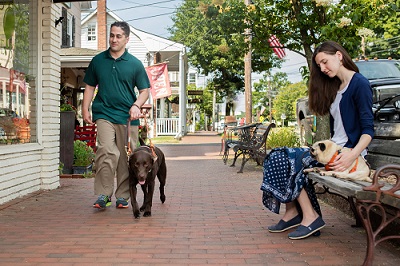For Immediate Release
Contact: Michelle Barlak, 973-775-8350
mbarlak@seeingeye.org
February 6, 2023
Survey Reveals Gap in Public Perception: Seemingly Innocent Interactions Harmful to Seeing Eye® Teams
Study Published in Journal of Visual Impairment & Blindness Reveals Need for Education

Morristown, N.J. – In a study published in the Journal of Visual Impairment & Blindness, 89% of Seeing Eye dog handlers had experienced people interfering with the work of their dogs by talking to or enticing them through deliberate, prolonged eye contact. Seeing Eye dog handlers who were surveyed commented that while talking to or petting their dogs without permission, members of the public made statements such as, “I know I’m not supposed to, but I can’t help myself.” Subtle public interactions such as making eye contact or saying hello to a guide dog may seem innocuous, but these momentary distractions can lead to embarrassment or even jeopardize the team’s safety.
“We know that people love animals and are fascinated by something they may not understand very well, which is the guide dog and handler partnership,” says Melissa Allman, the advocacy & government relations specialist at The Seeing Eye. “As a Seeing Eye dog handler myself, I am relying on my dog to safely guide me, and when someone pulls her attention away from that task, it’s disruptive and could lead to injury.”
The study also examined interference from pet dogs and revealed that pet owners tend to overestimate their own ability to manage their canines when encountering a guide dog team. More than three-quarters of respondents reported leashed but poorly controlled dogs as the main source of distraction from other dogs.
“I rely on my dog to help me travel throughout my daily life in a safe and dignified manner,” Allman explains. “When an unfamiliar dog approaches us, it’s startling because I can’t see the dog’s body language and protect myself or my dog if that dog is unfriendly. We count on pet owners to be responsible and keep their dogs at a safe distance.”
Key Takeaways From the Study
- 89% of Seeing Eye dog handlers experienced people interfering with the work of their dogs at least occasionally by talking to them or making eye contact
- 78% had experienced interference from other dogs regularly; interference from other dogs was usually non-aggressive
- 78.7% of respondents reported interference from leashed but uncontrolled dogs
- Loose dogs interfered with 61.8% of respondents’ dogs
- 36% reported other dogs making aggressive physical contact with their dogs
How You Can Help
- Please ignore working dogs when you encounter them. Petting, talking to, or making deliberate, prolonged eye contact with a working guide dog is distracting to the dog and interferes with the handlers travel and their safety
- Always keep your pet away from a guide dog, even if your dog is leashed. Let the blind person know you are there. A quick greeting such as “Hello, I have a dog with me” is often appreciated
- Keep your dog under good control at all times. Follow the leash laws for your area. Avoid the use of a retractable leash in populated areas or leaving your dog tied up outside unattended.
- Offer assistance to a blind handler if you witness an attack or interference on a guide dog team. A sighted witness to an attack is valuable if law enforcement is called to the scene. If it is your dog that causes harm, please take responsibility for its actions.
For more information about a public service campaign to spread awareness about how to interact with a guide dog team, please visit www.seeingeye.org/public
# # #
This article, “Interference With the Work of Dog Guides in Public: A Survey”, by Melissa Allman, Kathleen Freeberg, and Katy M. Evans and published in Journal of Visual Impairment & Blindness, will be free to access for a limited time and can be read here https://journals.sagepub.com/share/CEUD2MIPJQTPQ775FERP?target=10.1177/0145482X221132540
About The Seeing Eye
Established in 1929, The Seeing Eye provides specially bred and trained dogs to guide people who are blind. Seeing Eye dog users experience greatly enhanced mobility and independence, allowing them to retain their active lifestyles despite blindness. The Seeing Eye is a 501(c)3 non-profit supported by contributions from individuals, corporations and foundations, bequests, and other planned gifts.
The Seeing Eye is a trademarked name and can only be used to describe the dogs bred and trained at the school’s facilities in Morristown, N.J. If you would like more information on The Seeing Eye, please visit the website at www.SeeingEye.org, call (973) 539-4425, or email info@seeingeye.org.
# # #





